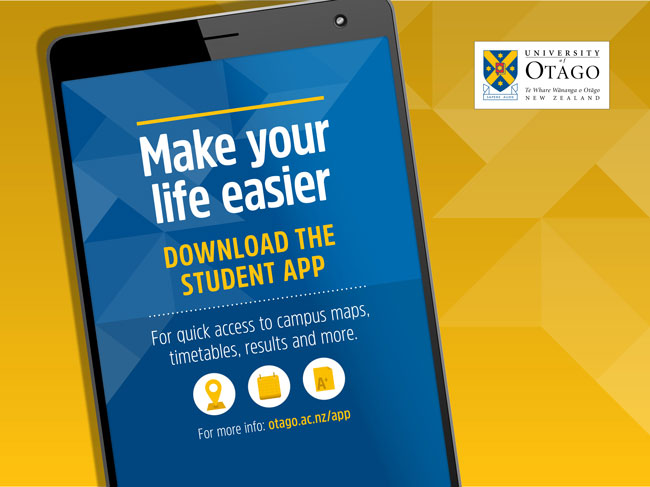
The University of Otago Student App is available now.
A free mobile app designed to make students' lives easier has been launched today – aiming to provide information where students normally get it: on their phones.
University of Otago Information Technology Services Director Mike Harte says the University of Otago Student App, available on both Android and iOS phones, is a one-stop shop for students.
Once they sign in with their student username and password they can see:
- Timetable – their study timetable from eVision
- Grades – their final results from eVision. Staff need to enter internal assessment results into eVision for students to see them in the app as well
- A Dunedin campus map to pinpoint course and tutorial venues, libraries, cafes, help from AskOtago, emergency telephones
- Students' academic orientation events and key academic dates (campus tours, introduction lectures, deadlines for enrolling etc) – by incorporating event information from the University online calendar
- Notification of University emergencies, and updates as the University posts them
- Useful contacts, including help service AskOtago, Campus Watch security, the University's social media
- Links to resources, including Blackboard, Moodle, eVision, the student desktop, libraries
- Current weather readings from the Dunedin campus weather station
The app is available at otago.ac.nz/app and at the App Store and Play Store as University of Otago.
Staff can also download and log into the app to see the kind of information students are getting. Staff can help make the app a success as well, by spreading the word it is available, and putting internal assessment results into eVision, so students can see those marks as well as their final academic results.
"The days of packing a whole lot of features into an app and saying 'we've all finished' are over. It's about adding features as you go and going back to make sure the app meets the needs of students."
Mr Harte says students can help make the app even better too, by using an easy feedback option on the app to tell the University what they would like to see in it next and report any issues.
“The days of packing a whole lot of features into an app and saying 'we've all finished' are over,” he says. “It's about adding features as you go and going back to make sure the app meets the needs of students.”
Students were consulted via on-campus workshops and Facebook before the app was developed, to find out what they wanted.
The next step is to consult students on Otago's campuses in Wellington, Christchurch and Invercargill about what they would like to see in the app.
It has limited functions for those campuses because they are single sites and predominantly use Moodle, so most students' results and timetables are not in eVision – the app only pushes information out from eVision, Mr Harte says.
The head of the Office of Student Success and the Locals Programme, Dr Stephen Scott, has no doubt the app is the right channel. He says 93 per cent of first-year students are younger than 20, “live on their phones,” are used to information being delivered to their phones in a clever way and already use many apps.
Most first-years also spend quite a lot of time initially getting lost on the Dunedin campus – “the University can be a complex place to navigate and many of the buildings they need to go to can be challenging to find.”
Having a map of the campus linked to the venues for lectures, tutorials and labs should help prevent students having that problem – while having links to key contacts will help students learn about Student Health, the Otago University Students' Association and other useful services, he says.